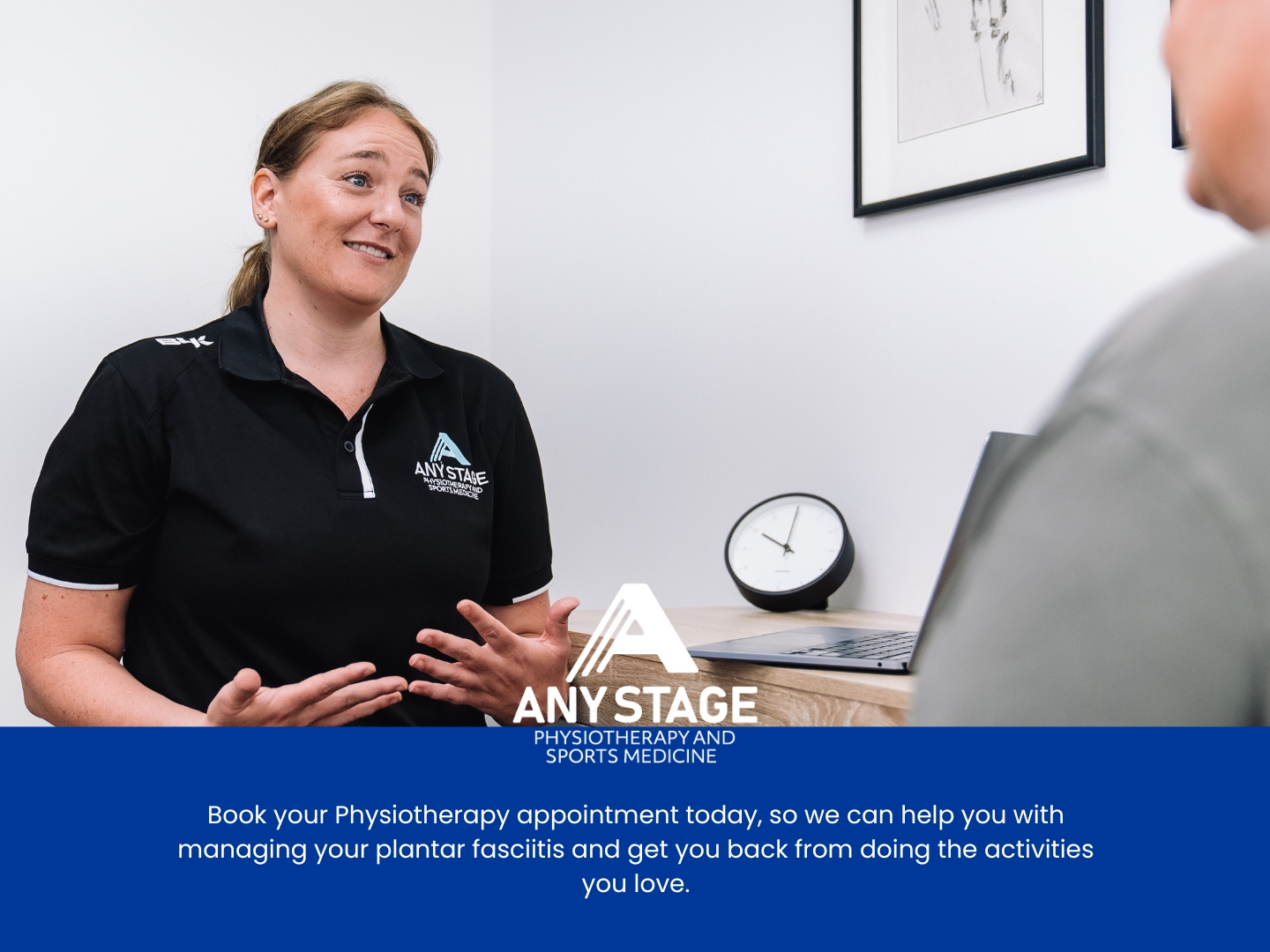What is Plantar Fasciitis?
Plantar fasciitis is a common condition that presents as heel pain, specifically pain in the plantar fascia, which is a thick band of tissue that runs along the bottom of the foot, connecting the heel bone to the toes. It is one of the most common causes of heel pain in adults. A typical presentation of plantar fasciitis includes significant heel pain with the first few steps in the morning.
The plantar fascia acts as a shock absorber and supports the arch of the foot. When excessive stress is placed on the plantar fascia, it can become inflamed, irritated, and develop microtears, leading to the development of plantar fasciitis.
Anatomy
The plantar fascia is a thick band of connective tissue that runs along the bottom of the foot, from the heel bone (calcaneus) to the base of the toes. It provides support to the arch of the foot and acts as a shock absorber during walking, running, and other weight-bearing activities. The plantar fascia is made up of three distinct portions: medial, central, and lateral bands.
Causes of Plantar Fasciitis
Common factors that can contribute to the development of plantar fasciitis include:
- Overuse, variable or repetitive stress: Activities that involve repetitive impact on the foot, such as running, jumping, or dancing, can strain the plantar fascia and lead to inflammation. Inconsistent activity levels can also contribute to plantar fasciitis.
- Foot mechanics: Certain foot mechanics, such as flat feet (pronation) or high arches (supination), can put additional stress on the plantar fascia.
- Improper footwear: Wearing shoes with poor arch support, inadequate cushioning, or inappropriate fit can increase the risk of developing plantar fasciitis.
- Body weight: Excess body weight can place added stress on the plantar fascia and contribute to its inflammation.
- Age and activity level: Plantar fasciitis is more common in middle-aged individuals and those who engage in activities that place excessive stress on the feet.
Symptoms of Plantar Fasciitis
The inflammation and microtears in the plantar fascia result in pain, typically a sharp, stabbing, or aching pain felt at the bottom of the heel or along the arch of the foot. The pain is often most pronounced in the morning or after periods of inactivity when the plantar fascia tightens and stretches. As weight is placed on the foot, the tension on the injured plantar fascia can worsen the pain.
Diagnosis and assessment
Diagnosis of plantar fasciitis is usually based on a physical examination and a review of the individual’s symptoms and medical history. Imaging tests, such as X-rays or ultrasound, may be ordered to rule out other conditions, such as stress fractures or heel spurs, which can be associated with plantar fasciitis.
Treatment options for Plantar Fasciitis
Treatment for plantar fasciitis typically involves conservative measures and can include:
- Physiotherapy: Physiotherapy is recommended to strengthen the foot muscles and improve flexibility, while guiding you through the below strategies.
- Rest and activity modification: Avoiding activities that worsen symptoms and giving the foot time to heal.
- Ice therapy: Applying ice to the affected area can help reduce pain and inflammation.
- Stretching exercises: Specific stretching exercises targeting the calf muscles and the plantar fascia can help relieve tension and promote healing.
- Supportive footwear: Wearing shoes with good arch support, cushioning, and proper fit can help reduce stress on the plantar fascia.
- Orthotic devices: Custom-made shoe inserts or orthotic devices can provide additional support and alignment for the foot.
- Night splints: Wearing a splint or brace at night can help stretch the plantar fascia and prevent morning pain.
- Nonsteroidal anti-inflammatory drugs (NSAIDs): Over-the-counter pain relievers, such as ibuprofen or naproxen, can help reduce pain and inflammation. (Please consult with her medical doctor before taking any medications).
Stretching exercises for Plantar Fasciitis
Specific stretches targeting the calf muscles can help alleviate tightness and reduce stress on the plantar fascia. Arch-supportive footwear or orthotic inserts can also help support the arch and minimise excessive strain on the plantar fascia during activities. Here are some specific exercises that can help alleviate symptoms of plantar fasciitis:
Calf Stretches
- Stand facing a wall, placing your hands on the wall for support.
- Step one foot back while keeping it straight, with the heel on the ground.
- Lean forward, bending the front knee, until you feel a stretch in the calf of the back leg.
- Hold the stretch for 30 seconds and then switch legs.
- Repeat this stretch 2-3 times on each leg.
Plantar Fascia Stretch
- Sit on a chair and cross one foot over the opposite knee.
- Grab the base of the toes of the crossed foot with one hand and gently pull them back toward the shin until you feel a stretch along the arch of the foot.
- Hold the stretch for 30 seconds and then release.
- Repeat this stretch 2-3 times on each foot.
Towel Stretch
- Sit on the floor with your legs extended in front of you.
- Place a towel around the ball of your foot and hold onto both ends.
- Gently pull the towel toward you, flexing your foot and stretching the calf and plantar fascia.
- Hold the stretch for 30 seconds and repeat 2-3 times on each foot.
Marble Pick-Up
- Place a small bowl or cup filled with marbles on the floor in front of you.
- Using your toes, pick up one marble at a time and transfer it to another bowl or cup.
- Continue picking up marbles for 1-2 minutes.
- This exercise helps strengthen the muscles in the foot and improve flexibility.
Toe Curls
- Sit on a chair with your feet flat on the floor.
- Place a towel or small towel underneath your toes.
- Using your toes, scrunch up the towel by curling them inward.
- Hold the curl for a few seconds, then release and repeat for a total of 10-15 repetitions.
- This exercise helps strengthen the muscles of the foot, including the plantar fascia.
Strengthening exercises for Plantar Fasciitis Rehabilitation
Strengthening of the intrinsic foot muscles, calf complex (gastrocnemius and soleus) plays a significant role in progressing the load tolerance through the plantar fascia and is introduced early in the rehabilitation process. Global strengthening of the hamstring, quadricep and gluteal muscle groups are also introduced in preparation of returning you to a pain free lifestyle.
Continued management
The majority of individuals with plantar fasciitis improve with conservative treatment. However, in rare cases where conservative measures fail to provide relief, more advanced interventions such as corticosteroid injections may be considered. Surgical intervention is typically reserved for cases that do not respond to conservative treatment after an extended period.


Final thoughts on Plantar Fasciitis
Plantar fasciitis is a condition that requires patience and consistent management. The healing process can be gradual, and it may take time to see significant improvement. It’s crucial to be proactive in following a comprehensive treatment plan and making lifestyle modifications to support healing.
Assistance
If you are currently experiencing symptoms of plantar fasciitis, please do not hesitate to contact our friendly and experienced staff at Any Stage Physiotherapy and Sports Medicine. We will provide an accurate diagnosis and appropriate management strategies, specific to your lifestyle and goals.
Authors


Daniel Lee
DPT, B. Sc, APAM
Director / Principal Physiotherapist
Daniel Lee has created a specialised approach to Physiotherapy treatment, return to sport and injury prevention by incorporating a functional strength & conditioning approach, no matter the individual’s age, sport, lifestyle, or competition level.

Shannon Murray
DPT, B. HSc, APAM
Physiotherapist
Shannon completed her Doctor of Physiotherapy degree at Macquarie University, after relocating from Queensland, where she completed her Bachelor of Health Science degree. Whilst completing her Doctor of Physiotherapy degree, she gained valuable experience in various setting, including private practice and hospital.









